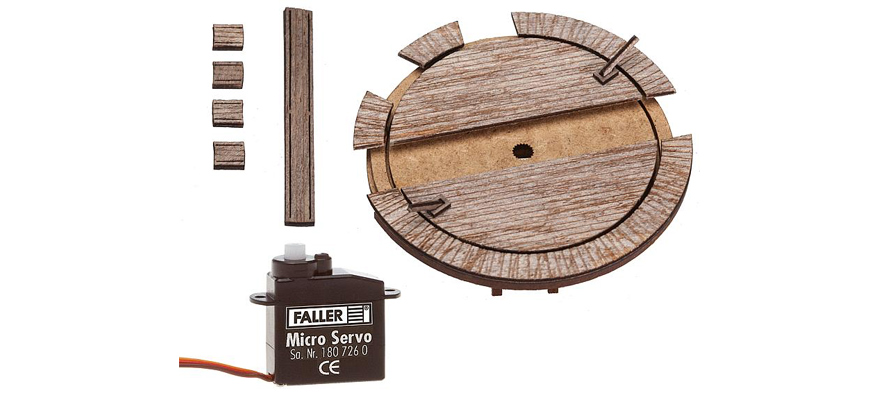Faller - 222114 - Turntable - Track, N Scale
Click to see the details
history
| Stock Number | 222114 |
| Original Retail Price | 40.99€ |
| Brand | Faller |
| Manufacturer | Faller |
| Body Style | Faller Structures |
| Prototype | Turntable |
| Road or Company Name | Track, N Scale (Details) |
| Reporting Marks | Turntable, Motorized |
| Paint Color(s) | Gray |
| Ready-to-Run | No |
| Kit Complexity | Moderate Skills |
| Release Date | 2016-11-01 |
| Item Category | Track |
| Model Type | Buildings |
| Scale | 1/160 |
Model Information:
Polystyrene structure kits. Some kits are unpainted while other kits are painted, but relatively easy to assemble.
Road Name History:
 Can't have model trains without track can we? The track on a railway or railroad, also known as the permanent way, is the structure consisting of the rails, fasteners, railroad ties (sleepers, British English) and ballast (or slab track), plus the underlying subgrade. It enables trains to move by providing a dependable surface for their wheels to roll upon. For clarity it is often referred to as railway track (British English and UIC terminology) or railroad track (predominantly in the United States). Tracks where electric trains or electric trams run are equipped with an electrification system such as an overhead electrical power line or an additional electrified rail.
Text and Images From Wikipedia
Can't have model trains without track can we? The track on a railway or railroad, also known as the permanent way, is the structure consisting of the rails, fasteners, railroad ties (sleepers, British English) and ballast (or slab track), plus the underlying subgrade. It enables trains to move by providing a dependable surface for their wheels to roll upon. For clarity it is often referred to as railway track (British English and UIC terminology) or railroad track (predominantly in the United States). Tracks where electric trains or electric trams run are equipped with an electrification system such as an overhead electrical power line or an additional electrified rail.
Text and Images From Wikipedia
Rail codes:
The code refers to the actual height of the rail. The followings heights are used for N-scale:
- Code 80 = 0.080" tall or about 13" N scale height - the mostly used for sectional tracks.
- Code 70 = 0.070" tall or about 11" N scale height
- Code 55 = 0.055" tall or about 9" N scale height - the mostly used by modelers wishing a realistic effect for their layout. Can be used with all modern rolling stock (low flange wheels).
- Code 40 = 0.040" tall or about 6" N scale height
Turnout codes:
The turnout number describes the length needed for the diverging track to be 1 foot apart from the straight one . So the lower the number, the sharper the curve, and the higher the number, the more gradual curve on the diverging track.
- In a #4 turnout, the rails are 1 foot apart at a distance 4 feet beyond the frog
- In a #6 turnout, the rails are 1 foot apart at a distance 6 feet beyond the frog
- In a #8 turnout, the rails are 1 foot apart at a distance 8 feet beyond the frog
Note that European brands such as Minitrix or Fleischmann use a different notation for turnouts and refer to the radius of the curvature of the diverging track.

Rail codes:
The code refers to the actual height of the rail. The followings heights are used for N-scale:
- Code 80 = 0.080" tall or about 13" N scale height - the mostly used for sectional tracks.
- Code 70 = 0.070" tall or about 11" N scale height
- Code 55 = 0.055" tall or about 9" N scale height - the mostly used by modelers wishing a realistic effect for their layout. Can be used with all modern rolling stock (low flange wheels).
- Code 40 = 0.040" tall or about 6" N scale height
Turnout codes:
The turnout number describes the length needed for the diverging track to be 1 foot apart from the straight one . So the lower the number, the sharper the curve, and the higher the number, the more gradual curve on the diverging track.
- In a #4 turnout, the rails are 1 foot apart at a distance 4 feet beyond the frog
- In a #6 turnout, the rails are 1 foot apart at a distance 6 feet beyond the frog
- In a #8 turnout, the rails are 1 foot apart at a distance 8 feet beyond the frog
Note that European brands such as Minitrix or Fleischmann use a different notation for turnouts and refer to the radius of the curvature of the diverging track.
Brand/Importer Information:
Faller is a German toy company founded in Stuttgart in 1946 by brothers Edwin and Hermann Faller. The company later relocated to the brothers' home town of Gütenbach in the Black Forest.
Faller now specializes in making scenery, plastic model kits and other accessories for model railroads but has manufactured a range of toys during its history, such as model aeroplane kits, the Auto Motor Sport (AMS) slot car racing sets and die-cast model cars. Their modern product line includes railway structures, houses and commercial buildings, bridges, amusement rides and terrain accessories in H0, N, TT and Z scales, as well as the Car System. Since 1997 Faller also owns the Pola brand, which is now solely devoted to G scale structures.
Faller's older toys and models can be highly collectable today, together with their early product catalogues.
From Wikipedia
Faller now specializes in making scenery, plastic model kits and other accessories for model railroads but has manufactured a range of toys during its history, such as model aeroplane kits, the Auto Motor Sport (AMS) slot car racing sets and die-cast model cars. Their modern product line includes railway structures, houses and commercial buildings, bridges, amusement rides and terrain accessories in H0, N, TT and Z scales, as well as the Car System. Since 1997 Faller also owns the Pola brand, which is now solely devoted to G scale structures.
Faller's older toys and models can be highly collectable today, together with their early product catalogues.
From Wikipedia
Item created by: gdm
on 2017-07-19 08:45:19
If you see errors or missing data in this entry, please feel free to log in and edit it. Anyone with a Gmail account can log in instantly.
If you see errors or missing data in this entry, please feel free to log in and edit it. Anyone with a Gmail account can log in instantly.



